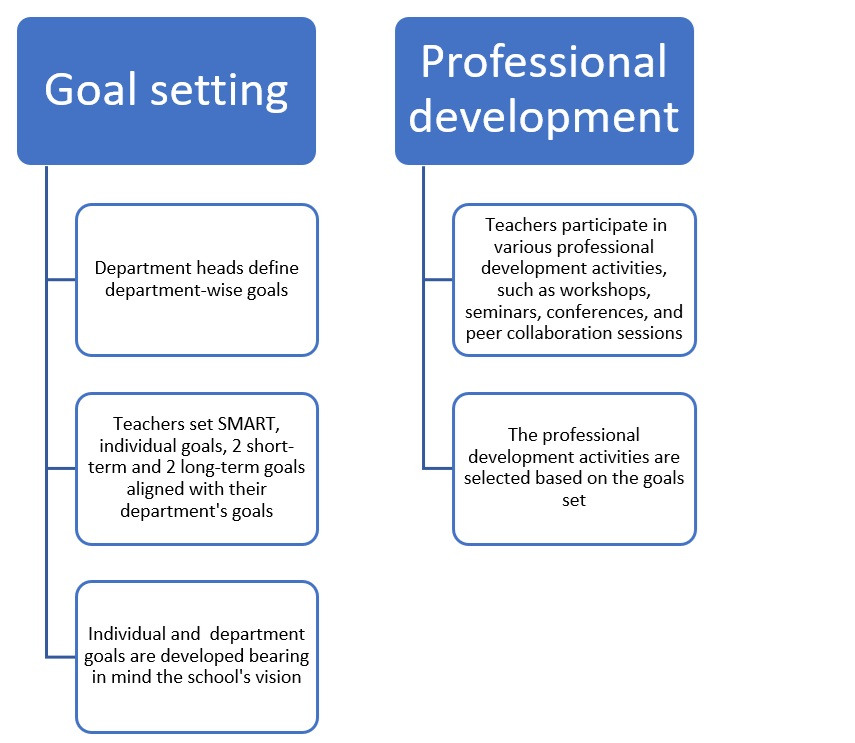How can school leaders support teachers to continually improve their classroom practice? In our latest reader submission, Secondary School Principal Aprajita Ralli shares examples of teacher development at Sreenidhi International School, including goal setting, mentorship and feedback.
At Sreenidhi International School, Hyderabad our commitment to professional development is grounded in the belief that empowered and continuously improving teachers are crucial for delivering high quality education.
Here, I’ve outlined the strategies we employ to help teachers set and achieve meaningful goals, supported by the 4-phased appraisal cycle, ensuring sustained professional growth and overall school improvement. Through a culture of continuous growth and targeted support, we strive to ensure that our teachers not only reach their individual professional goals but also contribute significantly to the overall success of our institution.
Strategies
Clear goal setting: We’ve tried to establish a structured framework for our evaluation process. We place strong emphasis on helping teachers set SMART goals: Specific, Measurable, Achievable, Relevant, and Time-bound. This ensures that teachers focus on targeted areas for improvement and professional growth, enhancing their teaching effectiveness and student outcomes.
For instance, a science teacher set a goal to integrate more hands-on experiments into her classes. Over the academic year, she introduced monthly lab experiments, significantly increasing student engagement and interest in science-related fields. This example highlights how a clear, measurable, and relevant goal can substantially improve teaching practice and student learning experiences.
This is closely monitored by the heads of the departments and the academic coordinators, ensuring that the teacher-set goals are in alignment with the school's vision and mission statements.
Regular professional development: Our teachers attend regular workshops, seminars, in-house, and external training programs designed to help them acquire new skills and stay updated with the latest educational trends and methodologies. These are in sync with the goals they have set for themselves for the academic year.
For example, a history teacher attended a workshop on differentiated instruction and subsequently implemented new strategies to address the diverse learning needs of her students. This led to improved student performance and engagement, as reflected in end-of-term evaluations and higher overall grades.
By offering continuous and ongoing training opportunities, we ensure that our teachers are equipped with the knowledge and tools necessary to meet their professional development goals and enhance their instructional practices.
Mentorship and peer collaboration: We recognise the importance of mentorship and peer collaboration in fostering teachers’ professional growth. Experienced teachers and mentors provide guidance and support to their colleagues, creating an environment where best practices can be shared, and collaborative learning can thrive.
A new teacher was paired with a veteran mentor who provided practical advice and strategies for effective classroom management. Through regular meetings and classroom observations, the new teacher reported fewer classroom disruptions and increased student participation. Such collaborations are undertaken in a non-threatening environment and space.
Regular feedback and reflection: Constructive feedback is the backbone of all our collective efforts. At our school, we believe in 360-degree feedback, wherein, teachers receive ongoing feedback from varied stakeholders – including administrators, peers and students – which is crucial for reflection and continuous improvement.
For example, a language teacher received feedback indicating a need for more interactive activities. In response, she incorporated group discussions and peer review sessions into her lesson plans, resulting in higher student engagement and improved writing skills.
This approach not only helps teachers identify their strengths and areas for development, but also encourages them to reflect on their practices and make necessary adjustments to enhance their teaching effectiveness and progress towards their goals.
Recognition and celebration of achievements: If one doesn't acknowledge success, one prepares the system for failure. At our school, we make it a point to acknowledge both big and small successes, reinforcing the importance of continuous professional growth.
The teacher who successfully implemented innovative teaching styles or the department head who conducted training sessions for other teachers from different schools are recognised in the staff assembly and featured in the school news update, which is also shared with parents. We also write letters of appreciation for teachers, which are put on their records.
By celebrating achievements, we foster a positive and motivating environment that encourages continuous improvement and professional growth. Our teachers are keen to participate in teacher training sessions, publish articles, and share their gained knowledge.
Data-driven decision making: Data-driven decision making is integral to our professional development strategy. I maintain an Excel sheet that reflects the performance metrics of my team, which enables me to track the achievements and areas for development. I use this to track my teachers, and teachers use data to track their progress toward their goals, analyse student performance, and adjust their instructional strategies as needed.
Let’s say a mathematics teacher aimed to improve standardised test scores. By analysing previous test data, she identified specific areas where students struggled and tailored her instruction accordingly. This resulted in a 15% increase in test scores, demonstrating the effectiveness of using data to inform teaching practices and achieve professional development goals. By leveraging data, we ensure our teachers can make informed decisions that enhance their teaching effectiveness and student outcomes.
Alignment of goals with the school objectives: The most significant aspect of achieving success in any system is having a consistent and collective vision; and leadership must be proactive in promoting the vision. Ensuring that teachers’ goals are aligned with the school’s strategic objectives is crucial for creating a cohesive approach to student achievement and school improvement.
A physics teacher incorporated additional project-based learning activities into his curriculum, aligning his practices with the school’s objective to enhance STEM education. This resulted in a deeper student understanding of STEM concepts and increased interest in pursuing STEM careers.
By aligning individual goals with the school’s objectives, we create a unified vision and direction that supports both teacher growth and school improvement.
Figure 1. Professional development is linked with individual teacher goals

As this article outlines, Sreenidhi International School uses several strategies to help teachers continually improve their classroom practice.
As a school leader, what are the professional development needs of your teaching staff? How often are these reviewed and updated?
How do work with teachers to identify areas of development, and support them to set and achieve targeted goals?



